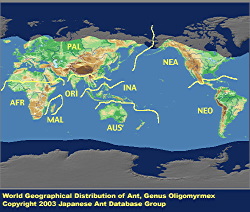
|
genus
|
Oligomyrmex
|
 |

|
|
Japanese Name
|
Kotsuno-ari-zoku
|
Original Reference
|
|
Mayr, G. (1867) Adnotationes in monographiam formicidarum Indo-Neerlandicarum. Tijdschrift voor Entomologie (2) 2 [10]: 33-117.
|
Description
|
|
Total length of workers around 1 - 4 mm. Worker caste dimorphic, without intermediates: comprising major workers, or "soldiers" and minor workers, or "workers". In soldiers the head is disproportionately very large, longer than wide, and often with a pair of bilateral tubercles on the vertex. Antennae with 8 - 11 segments, the two apical segments forming a club. Scapes short, not reaching the midlength of head. Mandibles robust, triangular, with 4 - 6 teeth. Clypeus usually with a pair of longitudinal carinae. Frontal carinae short. Eyes varying in size, facet numbers ranging from 2 or 3 to around 20. Palpal formula 2:2. Pro- and mesonotal dorsa more or less convex. Metanotal groove distinctly incised. Metanotum present and well defined in some species as a discreet sclerite. Propodeal spines present or absent. Subpetiolar process present or absent. Legs short. In workers: head relatively much smaller and not as strongly elongate as in soldiers; vertex without tubercles. Antennae as in soldiers; scapes proportionately long, but not reaching posterior margin of head. Eyes small, each with several facets. Metanotum absent; metanotal groove distinctly incised. Petiolar node relatively lower than in soldiers.
|
|

|
Remarks
|
|
Oligomyrmex comprises about 95 described species and is distributed almost worldwide, with most species in the African and Oriental tropics. Many species are terrestrial, nesting in leaf-litter, rotting wood, tree stumps or under stones. Five species have been reported in Japan.
|
References
|
|
- Adnotationes in monographiam formicidarum Indo-Neerlandicarum. Tijdschrift voor Entomologie (2) 2 [10]: 33-117.
|
Editor
|
|
Original text by Mamoru Terayama and Kazuo Ogata. English translation by Mamoru Terayama, edited by Robert W. Taylor.
|
|